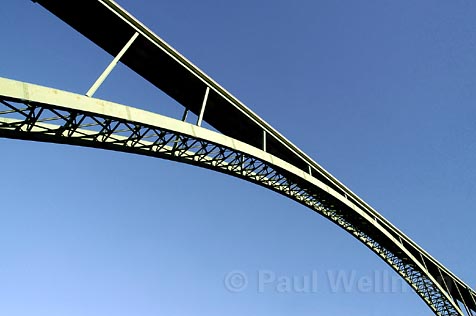Suicide Barrier Contract Awarded
Controversial Plan to Erect Fence on Cold Spring Bridge Moves Forward

The contract to erect a suicide barrier on the historic Cold Spring Bridge on Highway 154 was awarded yesterday, March 24, to Bugler Construction, a company based in the Bay Area town of Pleasanton. Work on the protective fence — which is intended to block those who want to kill themselves from leaping off the 1,200 foot span down to the rocky canyon roughly 420 feet below — is expected to start this summer, as long promised.
The project’s construction costs are expected to be $648,000, which will be covered by the $1.5 million in federal stimulus funds that the Santa Barbara County Association of Governments (SBCAG) earmarked for the project last year. According to Caltrans spokesman Jim Shivers, the remainder of that money has been or will be spent on other expenses, such as staff time, preparation of documents, and “all of the costs associated with the daily business of attending to and moving this project along.”

The barrier project has been in the planning stages for nearly four years, as a town hall meeting was held at Santa Barbara City College in May 2006 to discuss the idea. Mental health advocates and relatives of suicide jumpers targeted the bridge for its high number of suicides, a tally that tops 50 since the bridge opened in 1963. In 2009 alone, as the debate over whether to put up barriers on the bridge became more vocal and publicized in media far and wide, seven people leapt to their deaths.
Despite the imminent construction, the fight is still not over for people such as Marc McGinnes, a retired environmental studies professor at UCSB who formed Friends of the Cold Spring Bridge to preserve the bridge’s aesthetic beauty as an entryway to the Santa Ynez Valley and push for more effective means of suicide prevention. With the help of attorney Marc Chytilo, McGinnes is suing to stop the bridge barrier from being erected. He believes that the $1.5 million would be better spent on continuing the ongoing Highway 101 project and has argued to the federal government that it is an illegal misuse of federal stimulus funds under the provisions of the American Recovery and Reinvestment Act (ARRA).

“How can SBCAG claim with a straight face that it did not blunder terribly in diverting from the top-priority Highwy 101 program the $1.5 million in ARRA funds in its hands?” asked McGinnes on Wednesday afternoon in an email. Earlier in the day, he also left a voice message that reacted to a prior SBCAG story, explaining, “It just tells the story of how SBCAG and Caltrans raced ahead to insulate this diversion of Highway 101 funding from being subject to prioritization. One just has to wonder: What the hell is going on?” But McGinnes answered himself in the next breath. “Caltrans is in the business of spending money, and SCBAG is in the business of dealing with Caltrans and facilitating that relationship.” McGinnes believes that their fast, deliberate actions were a reaction to people, such as himself, who were “opposed very sternly and stiffly on this nutty suicide barrier project.”
SBCAG spokesperson Gregg Hart calls McGinnes’ charges “spurious.” Originally, Hart said that the federal stimulus funds had been banked to help pay for the 101 widening project; meanwhile, the bridge was going to be paid for with highway safety funding from the state and an earthquake-minded renovation of the Winchester Canyon Road overpass was going to be covered by basic state transportation funds. But with the recession, those basic funds dried up, so SBCAG diverted the special safety funding to cover the Winchester project, as it was in danger of falling behind schedule. They then took the $1.5 million in stimulus funds and put that toward the bridge barrier.
The funding, according to Hart, has nothing to do with Measure A, the initiative voters passed in 2008 to fund transportation projects countywide. “I don’t think Measure A is a part of this discussion,” he said.
As to McGinnes’ claim that such federal money cannot be used on the barrier, Hart responded, “They don’t care what we spend the money on as long as it’s a transportation project and as long as it is spent quickly.” Hart also said that the lawsuit does not preclude work from starting until a judge takes action. “Unless there’s an injunction,” he said, “Caltrans will be proceeding as business as usual.”


